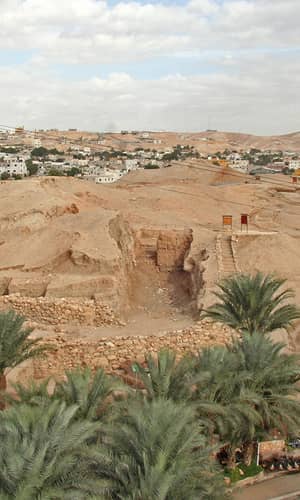The views expressed in this paper are those of the writer(s) and are not necessarily those of the ARJ Editor or Answers in Genesis.
Abstract
Habermehl’s (2024) discussion of Jericho has presented a good case for the Conquest, but then Habermehl loses her way archaeologically regarding the building of Jericho under Hiel the Bethelite.
In her recent paper, Habermehl (2024) has argued a good case for the archaeological horizon of the Conquest, and a number of revisionists including myself are in agreement with that identification. It is the only logical place where a significant change of culture occurs consistent with biblical predictions (Osgood 2020).
However, Habermehl (2024) then claims the rebuilding of Jericho during Middle Bronze 1 by Hiel (1 Kings 16:34). This latter conclusion is illogical even against her own previous claims, as I will show.
Now Habermehl (2018) has gone on record as claiming that the Eighteenth Dynasty of Egypt sits against the early Kingdom of Israel. I will not enter into the specifics of her conclusions here, but I have a difference of opinion on her claim, and I accept that general correlation.
However, if that conclusion is held, and we know that the Eighteenth Dynasty is clearly associated with the Late Bronze age, then Hiel’s building was after the early part of Israel’s kingdom, during the time of Ahab. This, clearly by her own claims here, Hiel could not have rebuilt Jericho before or even during the Middle Bronze age. In fact, the likely horizon of that rebuilt Jericho would be around the Late Bronze/Iron 1 interface.
Habermehl (2024) seems to place an arbitrary 500 years on the MB 1 (also known as EB/MB), a period I have argued suggests the nomadic then settling Israelites (Osgood 2020a, b), and so would not cover more than ca. 100 years. But I won’t labor that point.
Habermehl tells us that “we note that the Bible does not say that Hiel built a city, but only a wall.” Really, then what do the words “Hiel of Bethel built Jericho” mean? It had a foundation (not specifically of a wall) and it had gates (1 Kings 16:34).
But the archaeologists have clearly and categorically found a large city during Middle Bronze on the site of Jericho and therefore before Hiel. That city needs an explanation, as it won’t go away.
This is where I am amazed at the blindness of both conventional and revisionist discussions, as if the pages of the book of Judges are stuck together and a whole saga of history is excluded. Namely, there was the attack on Jericho, the city of palm trees, by Eglon of Moab, and for 20 years that site was occupied by 10,000 of his troops (Judges 3:12–30, see also Deuteronomy 34:3; Judges 1:16; 2 Chronicles 28:15—the city of palm trees).
Now a problem of understanding exists here, for if Eglon built on Jericho, why did he not fit into the curse uttered by Joshua? Examination of that curse and the story of Hiel will explain it. Although it was a curse, it cannot be claimed that it was a curse for anyone who rebuilt it, but was in fact a specific prophecy as well, under the inspirational guidance of the Holy Spirit.
Hiel had taken on Baal worship, and a part of Baal worship was the deliberate sacrifice of children. Hiel killed his firstborn son Abiram, placed his small body in a ceramic jar as the Baal worshipers were wont to do, and buried it in the foundation of Jericho. In so doing he dedicated Jericho to Baal. And then when he set up its gates, he killed his youngest son Segub, placed that corpse in a ceramic jar, and buried it in the foundation of the gates, for the same reason.
Joshua’s prophesy was a deliberate warning to Israel not to turn to Baal worship with which they were now familiar, and it had specific significance to Jericho which in the days of Joshua’s conquest was the first, and in that respect, the most important stage of their conquest.
Where then do we place Jericho’s rebuilding? Certainly, in or after the Late Bronze age of Palestine, not the Middle Bronze age or before. And the Late Bronze of Jericho’s archaeological horizon is much affected by erosion and other damage.
Conclusion
Habermehl’s (2024) placement of the conquest of Jericho has merit and I believe is essentially correct. However, her time placement of the rebuilding of Jericho is illogical, incorrect, and full of misunderstanding.
References
Habermehl, Anne. 2018. “Chronology and the Gezer Connection—Solomon, Thutmose III, Shishak and Hatshepsut.” Journal of Creation 32, no. 2 (August): 83–90.
Habermehl, Anne. 2024. “The Walls of Jericho: Dating Joshua’s Conquest of Canaan.” Answers Research Journal 17 (January 10): 1–8. https://answersresearchjournal.org/archaeology/jericho-dating-joshuas-conquest-of-canaan/.
Osgood, John. 2020a. “The Times of the Judges—Archaeology–Exodus to Conquest.” In They Speak with one Voice: A Correlation of the Bible Record with Archaeology. Self-published.
Osgood, John. 2020b. “The Times of the Judges—The Archaeology 2.” In They Speak with one Voice: A Correlation of the Bible Record with Archaeology. Self-published.





